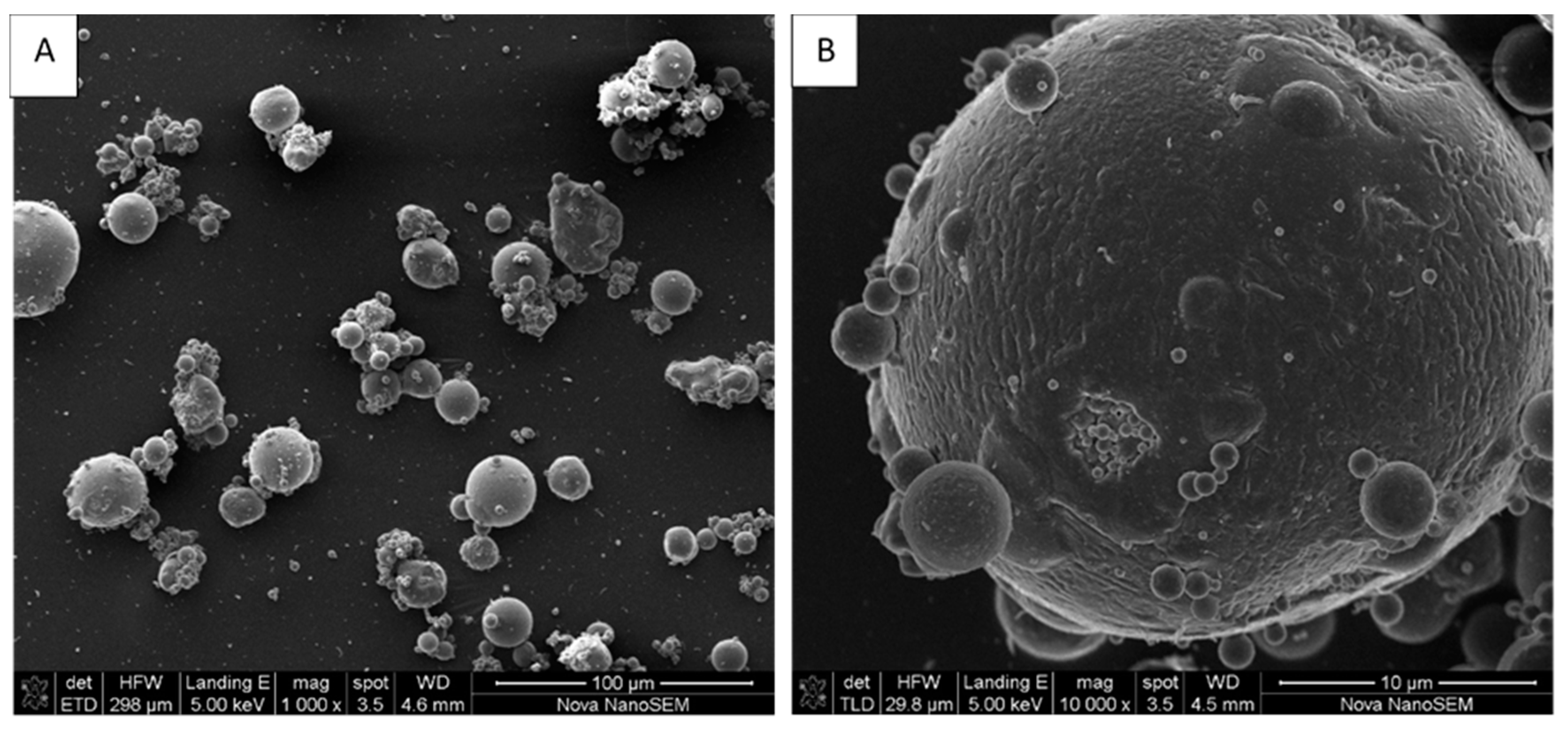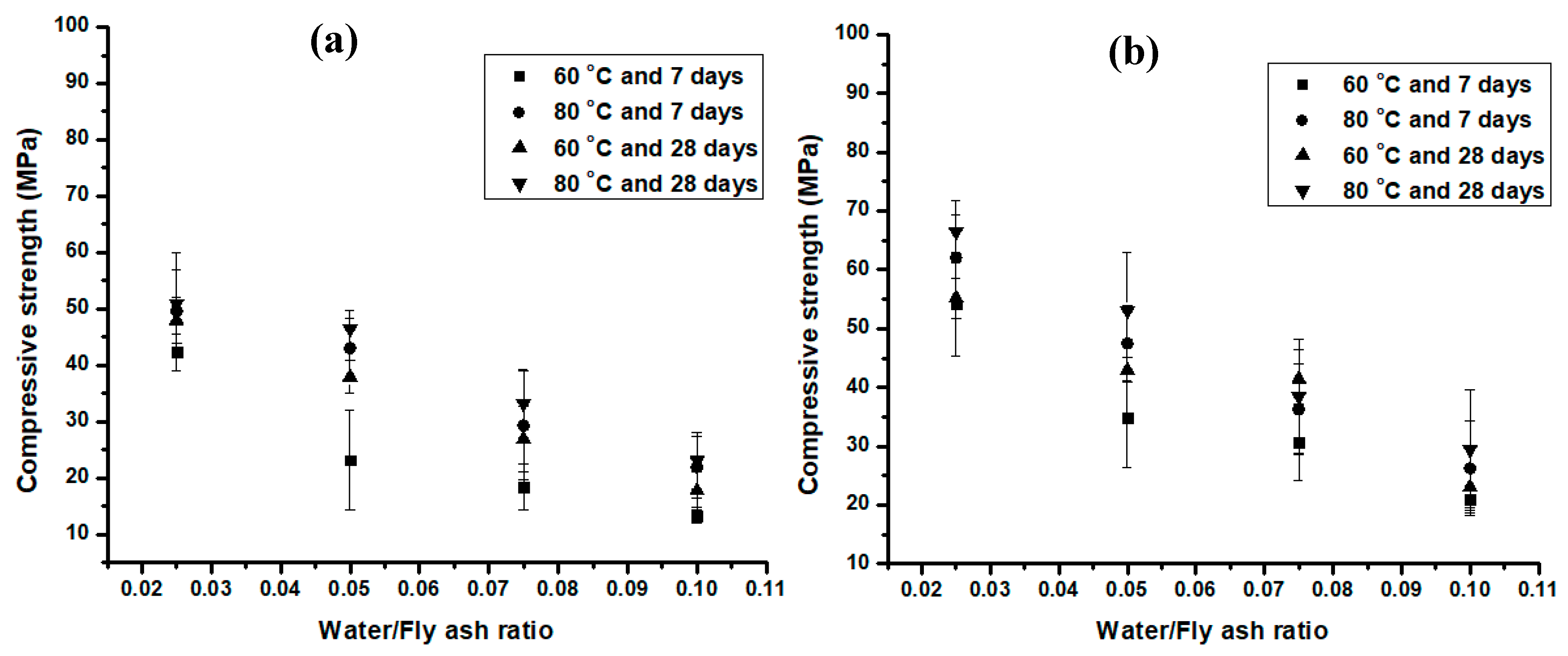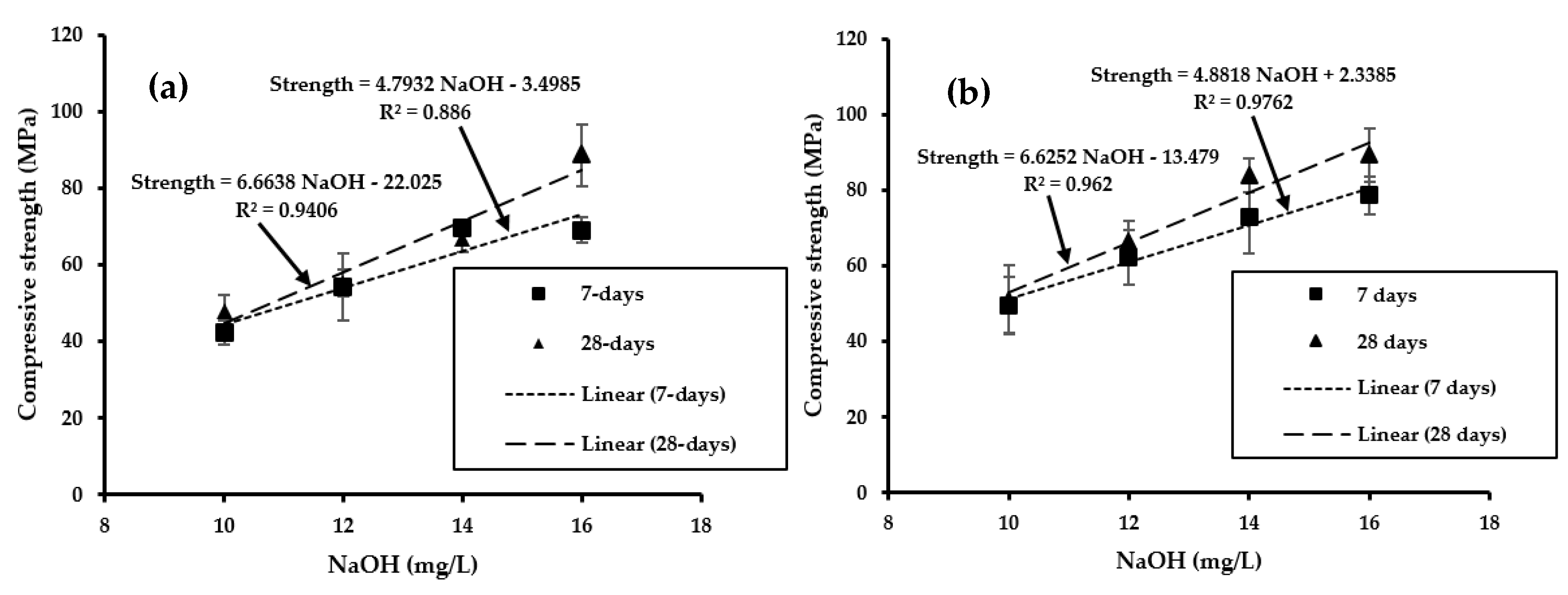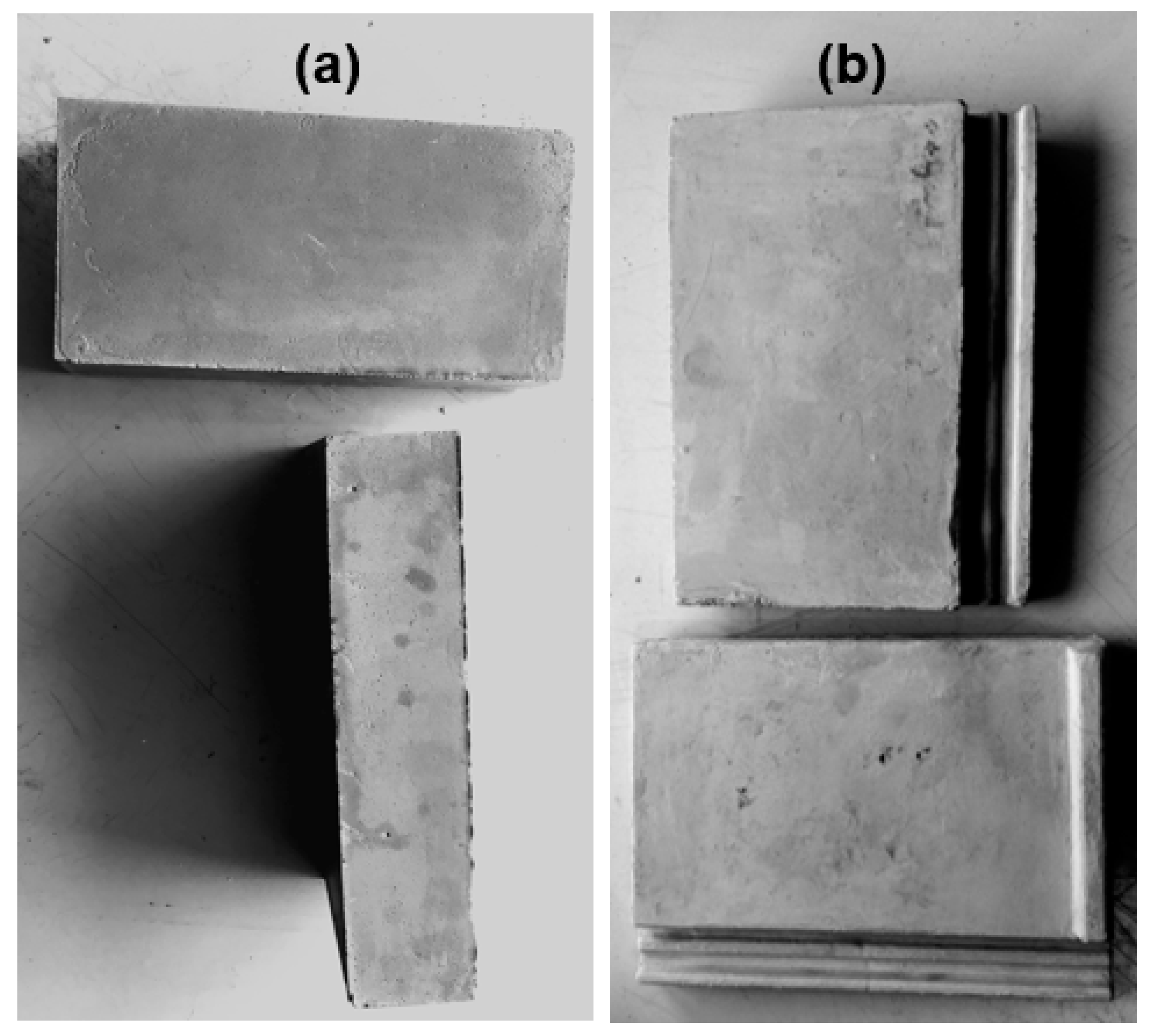Fly Ash-Based Geopolymer Building Materials for Green and Sustainable Development
Abstract
:1. Introduction
2. Materials and Methods
2.1. Raw Materials
2.2. Characterization of the Raw Material
2.3. Preparation of Materials and Experimental Procedure
2.4. Test Variables
2.5. Compressive Strength
2.6. Water Absorption
2.7. Production of Fly Ash-Based Roof Tiles and Paving Bricks
2.8. Estimation of the Quantity of CO2 Emitted by Cement and Fly Ash Products
3. Results and Discussion
3.1. Characterization of Coal Fly Ash
3.2. Compressive Strength
- The utilization of coal fly ash as the main source of silica, alumina, and lime, thus reusing this waste and resolving the disposal problem of coal-fired power station plant waste.
- No need for the addition of cement or aggregates to the geopolymer, thus reducing the mass and the carbon footprint of cement manufacturing
- No need for high temperature kilning
- Replacement of cement with coal fly ash in the construction industry
- Minimum addition of alkaline activators
- Reduced cost of geopolymerization process
3.3. Water Absorption of Geopolymer Products
3.4. Production of Fly Ash-Based Roof Tiles and Paving Bricks
3.5. Quantification of CO2 Emission from Cement and Fly Ash Products
4. Conclusions
- No coarse aggregate, sand, or cement was used in any of the formulations developed in this study. The compressive strengths of a series of experiments varied from 13.39 ± 1.42 to 89.32 ± 7.1 MPa. The increase in alkalinity during geopolymerization tended to decrease the product’s water absorption, which varied from 3.74 ± 0.78 to 7.55 ± 0.17%, indicating low water penetration.
- The best formulation and condition applied for the synthesis of a geopolymer with high strength of 89.32 ± 7.1 MPa consisted of a ratio of water/fly ash of 0.025:1, 16 M of NaOH, 80 °C curing temperature, and an aging time of 28 days.
- The fly ash-based roof tiles and paving bricks produced in this study had a compressive strength and water absorption of 47.98 ± 4.15 MPa and 7.55 ± 0.17%, respectively, meeting SANS 1058:2012 and SANS 542-2012 specifications.
- In order to produce bricks to build 6600 houses, cement materials produced a higher amount of CO2 compared to fly ash materials. A huge amount of fly ash was required compared to cement in order to produce the same amount of bricks, but a huge saving of sand was achieved. Approximately 140,303 tons of fly ash could be diverted from landfill and a reduction of 9179 tons of CO2 achieved when substituting fly ash bricks for conventional cement-based blocks in construction. Thus, these benefits help make fly ash an environmentally friendly choice for construction, with one of the lowest carbon footprints of any building material.
Author Contributions
Funding
Acknowledgments
Conflicts of Interest
References
- Gagg, C.R. Cement and Concrete as an Engineering Material: An Historic Appraisal and Case Study Analysis. Eng. Fail. Anal. 2014, 40, 114–140. [Google Scholar] [CrossRef]
- Caldas, L.; Martins, M.; Lima, D.; Sposto, R. Literature Review of Life Cycle Assessment Applied to Green Concretes. In Proceedings of the 6th Amazon & Pacific Green Materials Congress and Sustainable Construction Materials Lat-Rilem Conference, Cali, Colombia, 27–29 April 2016; pp. 775–788. [Google Scholar]
- Abdullah, M.M.A.B.; Jamaludin, L.; Hussin, K.; Bnhussain, M.; Ghazali, C.M.R.; Ahmad, M.I. Fly Ash Porous Material using Geopolymerization Process for High Temperature Exposure. Int. J. Mol. Sci. 2012, 13, 4388–4395. [Google Scholar] [CrossRef] [Green Version]
- Davidovits, J. False Values on CO2 Emission for Geopolymer Cement/Concrete published In Scientific Papers. Geopolym. Inst. Libr. Tech. Pap. 2015, 24, 1–9. [Google Scholar]
- Rodgers, L. Climate Change: The Massive CO2 Emitter You May Not Know About. BBC News 2018. Available online: https://www.bbc.com/news/science-environment-46455844 (accessed on 12 July 2020).
- “National Assembly Question no. 3383 nw3776e,” no. 3383. Department: Environmental Affairs. The Republic of South Africa. Available online: https://www.environment.gov.za/sites/default/files/parliamentary_updates/pq3383_tonsinash_producedbyEskomandSasol.pdf (accessed on 4 August 2019).
- Kalombe, R.M.; Ojumu, T.V.; Katambwe, V.N.; Nzadi, M.; Bent, D.; Nieuwouldt, G.; Madzivire, G.; Kevern, J.; Petrik, L.F. Treatment of acid mine drainage with coal fly ash in a jet loop reactor pilot plant. Miner. Eng. 2020, 159, 106611. [Google Scholar] [CrossRef]
- Madzivire, G.; Gitari, W.M.; Vadapalli, V.R.K.; Petrik, L.F. Jet loop reactor application for mine water treatment using fly ash, lime and aluminium hydroxide. Int. J. Environ. Sci. Technol. 2015, 12, 173–182. [Google Scholar] [CrossRef] [Green Version]
- Ndlovu, N.Z.N.; Missengue, R.N.M.; Petrik, L.F.; Ojumu, T. Synthesis and Characterization of Faujasite Zeolite and Geopolymer from South African Coal Fly Ash. J. Environ. Eng. 2017, 143, 04017042. [Google Scholar] [CrossRef]
- Plessis, P.W.D.; Ojumu, T.V.; Fatoba, O.O.; Akinyeye, R.O.; Petrik, L.F. Distributional fate of elements during the synthesis of zeolites from South African coal fly ash. Materials 2014, 7, 3305–3318. [Google Scholar] [CrossRef] [Green Version]
- Liguori, B.; Aprea, P.; Roviello, G.; Ferone, C. Self-supporting zeolites by Geopolymer Gel Conversion (GGC). Microporous Mesoporous Mater. 2019, 286, 125–132. [Google Scholar] [CrossRef]
- Yao, Z.T.; Ji, X.S.; Sarker, P.K.; Tang, J.H.; Ge, L.Q.; Xia, M.S.; Xi, Y.Q. A comprehensive review on the applications of coal fly ash. Earth-Sci. Rev. 2015, 141, 105–121. [Google Scholar] [CrossRef] [Green Version]
- Saravanan, G.; Jeyasehar, C.A.; Kandasamy, S. Flyash Based Geopolymer Concrete—A State of the Art Review. J. Eng. Sci. Technol. Rev. 2013, 6, 25–32. [Google Scholar] [CrossRef]
- Wang, J.W.; Cheng, T.W. Production geopolymer materials by coal fly ash. In Proceedings of the 7th International Symposium on East Asian Resources Recycling Technology, Tainan, Taiwan, 10–14 November 2003; Volume 2, pp. 263–266. [Google Scholar]
- Nyale, S.M.; Babajide, O.O.; Birch, G.D.; Böke, N.; Petrik, L.F. Synthesis and Characterization of Coal Fly Ash-based Foamed Geopolymer. Procedia Environ. Sci. 2013, 18, 722–730. [Google Scholar] [CrossRef] [Green Version]
- Prochon, P.; Zhao, Z.; Courard, L.; Piotrowski, T.; Michel, F.; Garbacz, A. Influence of Activators on Mechanical Properties of Modified Fly Ash Based Geopolymer Mortars. Materials 2020, 13, 1033. [Google Scholar] [CrossRef] [PubMed] [Green Version]
- Wattimena, O.K.; Antoni; Hardjito, D. A review on the effect of fly ash characteristics and their variations on the synthesis of fly ash based geopolymer. In AIP Conference Proceedings; AIP Publishing LLC: Melville, NY, USA, 2017; p. 1887. [Google Scholar]
- ASTM. Standard Speciation for Fly Ash and Raw or Calcined Natural Pozzolan for Uses as a Mineral Admixture in Portland Cement Concrete; ASTM C-618; ASTM: West Conshohocken, PA, USA, 2005. [Google Scholar]
- Li, X.; Ma, X.; Zhang, S.; Zheng, E. Mechanical properties and microstructure of class C fly ash-based geopolymer paste and mortar. Materials 2013, 6, 1485–1495. [Google Scholar] [CrossRef] [PubMed] [Green Version]
- Abdullah, M.M.A.; Kamarudin, H.; Bnhussain, M.; Nizar, I.K.; Rafiza, A.R.; Zarina, Y. The Relationship of NaOH Molarity, Na2SiO3/NaOH Ratio, Fly Ash/Alkaline Activator Ratio, and Curing Temperature to the Strength of Fly Ash-Based Geopolymer. Adv. Mater. Res. 2011, 328–330, 1475–1482. [Google Scholar] [CrossRef]
- Kaur, M.; Singh, J.; Kaur, M. Synthesis of fly ash based geopolymer mortar considering different concentrations and combinations of alkaline activator solution. Ceram. Int. 2018, 44, 1534–1537. [Google Scholar] [CrossRef]
- Xu, H.; van Deventer, J.S.J. The geopolymerisation of alumino-silicate minerals. Int. J. Miner. Process. 2000, 59, 247–266. [Google Scholar] [CrossRef] [Green Version]
- Thakur, A.K.; Pappu, A.; Thakur, V.K. Synthesis and characterization of new class of geopolymer hybrid composite materials from industrial wastes. J. Clean. Prod. 2019, 230, 11–20. [Google Scholar] [CrossRef]
- Barboza-Chavez, A.C.; Gómez-Zamorano, L.Y.; Acevedo-Dávila, J.L. Synthesis and characterization of a hybrid cement based on fly ash, metakaolin and portland cement clinker. Materials 2020, 13, 1084. [Google Scholar] [CrossRef] [Green Version]
- Nath, S.K. Fly ash and zinc slag blended geopolymer: Immobilization of hazardous materials and development of paving blocks. J. Hazard. Mater. 2020, 387, 121673. [Google Scholar] [CrossRef] [Green Version]
- Singh, B.; Rahman, M.R.; Paswan, R.; Bhattacharyya, S.K. Effect of activator concentration on the strength, ITZ and drying shrinkage of fly ash/slag geopolymer concrete. Constr. Build. Mater. 2016, 118, 171–179. [Google Scholar] [CrossRef]
- Rattanasak, U.; Chindaprasirt, P. Influence of NaOH solution on the synthesis of fly ash geopolymer. Miner. Eng. 2009, 22, 1073–1078. [Google Scholar] [CrossRef]
- Sathonsaowaphak, A.; Chindaprasirt, P.; Pimraksa, K. Workability and strength of lignite bottom ash geopolymer mortar. J. Hazard. Mater. 2009, 168, 44–50. [Google Scholar] [CrossRef] [PubMed]
- Patankar, S.V.; Jamkar, S.S.; Ghugal, Y.M. Effect of Water-To-Geopolymer Binder Ratio on the Production of Fly Ash Based Geopolymer Concrete. Int. J. Adv. Technol. Civ. Eng. 2013, 2, 79–83. [Google Scholar]
- Ryu, G.S.; Lee, Y.B.; Koh, K.T.; Chung, Y.S. The mechanical properties of fly ash-based geopolymer concrete with alkaline activators. Constr. Build. Mater. 2013, 47, 409–418. [Google Scholar] [CrossRef]
- Davidovits, J.; Quentin, S. GEOPOLYMERS Inorganic polymerie new materials. J. Therm. Anal. 1991, 37, 1633–1656. [Google Scholar] [CrossRef]
- Wang, Y.C.; Zhao, J.P. Facile preparation of slag or fly ash geopolymer composite coatings with flame resistance. Constr. Build. Mater. 2019, 203, 655–661. [Google Scholar] [CrossRef]
- Bakkali, H.; Ammari, M.; Frar, I. NaOH alkali-activated class F fly ash: NaOH molarity, Curing conditions and mass ratio effect. J. Mater. Environ. Sci. 2016, 7, 397–401. [Google Scholar]
- Morsy, M.S.; Alsayed, S.H.; Al-Salloum, Y.; Almusallam, T. Effect of Sodium Silicate to Sodium Hydroxide Ratios on Strength and Microstructure of Fly Ash Geopolymer Binder. Arab. J. Sci. Eng. 2014, 39, 4333–4339. [Google Scholar] [CrossRef]
- Kamarudin, H.; Al Bakri, A.M.; Binhussain, M.; Ruzaidi, C.M.; Luqman, M.; Heah, C.Y. Preliminary Study on Effect of NaOH Concentration on Early Age Compressive Strength of Kaolin-Based Green Cement. In Proceedings of the 2011 International Conference on Chemistry and Chemical Process IPCBEE, Bangkok, Thailand, 7–9 May 2011; Volume 10, pp. 18–24. [Google Scholar]
- Rangan, B.V.; Hardjito, D.; Wallah, S.E.; Sumajouw, D.M.J. Studies on fly ash-bas ed geopolymer concrete. In Proceedings of the World Congress Geopolymer, Saint Quentin, France, 30 June–2 July 1987; pp. 133–138. [Google Scholar]
- Wazien, A.Z.W.; Abdullah, M.M.A.B.; Razak, R.A.; Rozainy, M.A.Z.M.R.; Tahir, M.F.M. Strength and Density of Geopolymer Mortar Cured at Ambient Temperature for Use as Repair Material. In Proceedings of the IOP Conference Series: Materials Science and Engineering 2016, Iasi, Romania, 19–20 May 2016; p. 133. [Google Scholar]
- Catauro, M.; Papale, F.; Lamanna, G.; Bollino, F.; Engineering, I. Geopolymer/PEG Hybrid Materials Synthesis and Investigation of the Polymer Influence on Microstructure and Mechanical Behavior. Mater. Res. 2015, 18, 698–705. [Google Scholar] [CrossRef] [Green Version]
- Görhan, G.; Kürklü, G. The influence of the NaOH solution on the properties of the fly ash-based geopolymer mortar cured at different temperatures. Compos. Part. B Eng. 2014, 58, 371–377. [Google Scholar] [CrossRef]
- Ferone, C.; Colangelo, F.; Cioffi, R.; Montagnaro, F.; Santoro, L. Mechanical performances of weathered coal fly ash based geopolymer bricks. Procedia Eng. 2011, 21, 745–752. [Google Scholar] [CrossRef]
- Somna, K.; Jaturapitakkul, C.; Kajitvichyanukul, P.; Chindaprasirt, P. NaOH-activated ground fly ash geopolymer cured at ambient temperature. Fuel 2011, 90, 2118–2124. [Google Scholar] [CrossRef]
- Hardjito, D.; Wallah, S.E.; Sumajouw, D.M.; Rangan, B.V. On The Development of Fly Ash-based Geopolymer Concrete On the Development of Fly Ash-Based. ACI Mater. J. 2004, 101, 467–472. [Google Scholar]
- Hamid, A.; Alfaidi, H.; Baaj, H.; El-Hakim, M. Evaluating Fly Ash-Based Geopolymers as a Modifier for Asphalt Binders. Adv. Mater. Sci. Eng. 2020, 2020, 2398693. [Google Scholar] [CrossRef] [Green Version]
- Novais, R.M.; Carvalheiras, J.; Tobaldi, D.M.; Seabra, M.P.; Pullar, R.C.; Labrincha, J.A. Synthesis of porous biomass fly ash-based geopolymer spheres for efficient removal of methylene blue from wastewaters. J. Clean. Prod. 2019, 207, 350–362. [Google Scholar] [CrossRef]
- Chislov, M.V.; Kalinkina, E.V.; Zvereva, I.A.; Cherkezova-zheleva, Z.; Paneva, D.; Petkova, V. Synthesis of Fly Ash-Based Geopolymers: Effect of Calcite Addition and Mechanical Activation. Minerals 2020, 10, 827. [Google Scholar]
- Wardhono, A. The Durability of Geopolymer and Alkali-Activated Slag Concretes. 2014. Available online: https://www.semanticscholar.org/paper/The-durability-of-fly-ash-geopolymer-and-slag-Wardhono/18d37cb511642ad9e9da7edd59e3a5089bb0411e. (accessed on 25 November 2020).
- Hattamleh, M.N.A.O.; Akhtar, J.N. Feasibility of coal fly ash based bricks and roof tiles as construction materials: A review. In MATEC Web of Conferences; EDP Sciences: Ulis, France, 2017; p. 03008. [Google Scholar]
- ASTM. Standard Test Method for Water Absorption of Plastic; ASTM D570-98; ASTM: West Conshohocken, PA, USA, 2010. [Google Scholar]
- May, P.; No, A.; Sans, A.A.; Sans, A.B.; Sans, A.D.; Sans, A.H.; Sans, D.B.; Sans, D.E.; Sans, D.K.; Sans, D.M.; et al. SANS 1200 (Set): Standardized Specification for Civil Engineering Construction; South African Bureau of Standards: Pretoria, South Africa, 2003. [Google Scholar]
- Kayali, O. High Performance Bricks from Fly Ash. In Proceedings of the 2005 World Coal Ash, Lexington, KY, USA, 11–15 April 2005; pp. 1–13. [Google Scholar]
- Baiden, B.; Tuuli, M. Impact of Quality Control Practices in Sandcrete Blocks Production. J. Archit. Eng. 2004, 10, 53–60. [Google Scholar] [CrossRef]
- Nwofor, T.C. Durability of block work: The effect of varying water/cement ratio of mortar joint. Adv. Appl. Sci. Res. 2012, 3, 1848–1853. [Google Scholar]
- Corobrik South Africa. Technical Information. Corobrik SA 2020. Available online: https://www.corobrik.co.za/products/technical (accessed on 5 October 2020).
- Mahasenan, N.N.; Dahowski, R.T.; Davidson, C.L. The Role of Carbon Dioxide Capture and Storage in Reducing Emissions from Cement Plants in North America. In Greenhouse Gas Control Technologies 7; Elsevier: Amsterdam, The Netherlands, 2005; Volume 1. [Google Scholar]
- City of Winnipeg. Emission factors in kg CO2 equivalent per unit; Documents for Bid Opportunity 682 2012 _Appendix_H WSTP_South_End_Plant_Process_Selection_ Report Appendix 7. Available online: www.winnipeg.ca > 2012 > 682-2012 > Appendix 7.pdf (accessed on 12 April 2020).
- Heidrich, B.; Hinczak, C.; Ryan, I. Supplementary Cementitious Materials (SCMs) Potential to Lower Greenhouse Gas emissions for Australia. Concrete 2005, 2005, 67–74. [Google Scholar]
- Santero, A.; Loijos, A.; Ochsendorf, J. Greenhouse gas emissions reduction opportunities for concrete pavements. J. Ind. Ecol. 2013, 17, 859–868. [Google Scholar] [CrossRef]
- Singh, A. Advances in Global Change Research 68. Translating the Paris Agreement into Action in the Pacific; Springer Nature Switzerland AG.: Lautoka, Fiji, 2020; Available online: https://books.google.com/books? (accessed on 2 July 2020).
- Fawer, M.; Concannon, M.; Rieber, W. Life cycle inventories for the production of sodium silicates. Int. J. Life Cycle Assess. 1999, 4, 207–212. [Google Scholar] [CrossRef] [Green Version]
- Panias, D.; Giannopoulou, I.P.; Perraki, T. Effect of synthesis parameters on the mechanical properties of fly ash-based geopolymers. Colloids Surf. A Physicochem. Eng. Asp. 2007, 301, 246–254. [Google Scholar] [CrossRef]
- Musyoka, N.M.; Petrik, L.F.; Fatoba, O.O.; Hums, E. Synthesis of zeolites from coal fly ash using mine waters. Miner. Eng. 2013, 53, 9–15. [Google Scholar] [CrossRef] [Green Version]
- Openshaw, C.S. Utilization of Coal Fly Ash; Florida University Gainesville: Gainesville, FL, USA, 1992. [Google Scholar]
- Potgieter, J.; Bada, S.; Potgieter-Vermaak, S. Adsorptive removal of various phenols from water by South African coal fly ash. Water SA 2009, 35, 89–96. [Google Scholar] [CrossRef] [Green Version]
- Inada, M.; Tsujimoto, H.; Eguchi, Y.; Enomoto, N.; Hojo, J. Microwave-assisted zeolite synthesis from coal fly ash in hydrothermal process. Fuel 2005, 84, 1482–1486. [Google Scholar] [CrossRef]
- Kim, J.K.; Lee, H.D. Effects of step change of heating source on synthesis of zeolite 4A from coal fly ash. J. Ind. Eng. Chem. 2009, 15, 736–742. [Google Scholar] [CrossRef]
- Ayanda, O.S.; Fatoki, O.S.; Adekola, F.A.; Ximba, B.J. Characterization of fly ash generated from Matla power station in Mpumalanga, South Africa. E-J. Chem. 2012, 9, 1788–1795. [Google Scholar] [CrossRef]
- Eze, C.P. Chemical, Physical and Morphological changes in weathered Coal fly ash: A Case Study of Brine Impacted Wet Ash Dump. Ph.D. Thesis, University of the Western Cape Supervisor, Cape Town, South Africa, 2011. [Google Scholar]
- Styszko-Grochowiak, K.; Gołaś, J.; Jankowski, H.; Koziński, S. Characterization of the coal fly ash for the purpose of improvement of industrial on-line measurement of unburned carbon content. Fuel 2004, 83, 1847–1853. [Google Scholar] [CrossRef]
- Jansen, M.S.; Christiansen, M.U. Effect of Water-Solids Ratio on the Compressive Strength and Morphology of Fly Ash-Waste Glass Geopolymer Mortars. In Proceedings of the World of Coal Ash (WOCA) Conference 2015, Nasvhille, TN, USA, 5–7 May 2015. [Google Scholar]
- Yahya, Z.; Abdullah, M.M.A.B.; Hussin, K.; Ismail, K.N.; Razak, R.A.; Sandu, A.V. Effect of solids-to-liquids, Na2SiO3 to NaOH and curing temperature on the palm oil boiler ash (Si + Ca) geopolymerisation system. Materials 2015, 8, 2227–2242. [Google Scholar] [CrossRef]
- Sun, Q.; Tian, S.; Sun, Q.; Li, B.; Cai, C.; Xia, Y.; Mu, Q. Preparation and microstructure of fly ash geopolymer paste backfill material. J. Clean. Prod. 2019, 225, 376–390. [Google Scholar] [CrossRef]
- Bakharev, T. Resistance of geopolymer materials to acid attack Cem. Concr. Res. 2005, 35, 658–670. [Google Scholar] [CrossRef]
- Totaro, P. Drying for a Pee: Cape Town’s Slum Residents Battle for Sanition; Thomson Reuters Foundation: London, UK, 2016; Available online: https://www.reuters.com/article/us-safrica-slums-sanitation/dying-for-a-pee-cape-towns-slum-residents-battle-for-sanitation-idUSKCN12C1WA (accessed on 12 May 2020).






| Condition | Variable | Constant |
|---|---|---|
| 1 | Water/fly ash (wt) | Constant |
| 0.1:1 | NaOH/fly ash = 0.1:1, Na2SiO3/NaOH = 2.5:1, 60 °C, 7 days | |
| 0.075:1 | ||
| 0.05:1 | ||
| 0.025:1 | ||
| 2 | NaOH (mg/L) | Constant |
| 10 | Water/fly ash = 0.025:1, NaOH/fly ash = 0.1:1, Na2SiO3/NaOH = 2.5:1, 60 °C, 7 days | |
| 12 | ||
| 14 | ||
| 16 | ||
| 3 | Temperature (°C) | Constant |
| 60 | Water/fly ash = 0.025:1, NaOH/fly ash = 0.1:1, Na2SiO3/NaOH = 2.5, 7 days | |
| 80 | ||
| 4 | Age (day) | Constant |
| 7 | Water/fly ash = 0.025:1, NaOH/fly ash = 0.1:1, Na2SiO3/NaOH = 2.5:1 | |
| 28 |
| Cement Brick * | Fly Ash Brick | ||
|---|---|---|---|
| Water/Cement | 0.6:1 | Water/Fly ash | 0.1:1 |
| Sand/Cement | 6:1 | NaOH/Fly ash | 0.1:1 |
| Na2SiO3/NaOH | 2.5:1 | ||
| Material | CO2 Emission (kg) | Reference |
|---|---|---|
| Cement | 0.87 | [54] |
| Sand | 0.01 | [55] |
| Fly ash | 0.012 | [56] |
| Water | 0.005 | [57] |
| NaOH | 0.5297 | [58] |
| Na2SiO3 (37% liquid) | 0.424 | [4,59] |
| Major Oxides | A | B | C | Average |
|---|---|---|---|---|
| wt % | ||||
| SiO2 | 57.17 | 56.68 | 56.61 | 56.82 ± 0.31 |
| Al2O3 | 30.24 | 30.85 | 31.03 | 30.71 ± 0.41 |
| Fe2O3 | 3.64 | 3.65 | 3.62 | 3.63 ± 0.01 |
| CaO | 4.50 | 4.55 | 4.42 | 4.49 ± 0.07 |
| TiO2 | 1.61 | 1.61 | 1.59 | 1.60 ± 0.01 |
| MgO | 1.11 | 1.10 | 1.12 | 1.11 ± 0.01 |
| K2O | 0.71 | 0.72 | 0.67 | 0.70 ± 0.02 |
| P2O5 | 0.51 | 0.50 | 0.50 | 0.50 ± 0.01 |
| MnO | 0.03 | 0.02 | 0.03 | 0.03 ± 0.01 |
| Cr2O3 | 0.04 | 0.04 | 0.03 | 0.04 ± 0.01 |
| Na2O | 0.42 | 0.27 | 0.35 | 0.35 ± 0.07 |
| V2O5 | 0.03 | 0.02 | 0.03 | 0.03 ± 01 |
| Total | 100.00 | 100.00 | 100.00 | 100.00 ± 0.00 |
| SiO2/Al2O3 | 1.89 | 1.84 | 1.82 | 1.85 ± 0.04 |
| Si/Al | 1.61 | 1.56 | 1.55 | 1.57 ± 0.03 |
| NaOH (M) | Compressive Strength (MPa) | Water Absorption (%) |
|---|---|---|
| 10 | 47.98 ± 4.15 | 7.55 ± 0.17 |
| 12 | 55.21 ± 3.41 | 4.79 ± 0.20 |
| 14 | 66.64 ± 3.43 | 4.39 ± 0.83 |
| 16 | 88.59 ± 7.97 | 3.74 ± 0.78 |
| Cement Brick | Fly Ash Brick | ||||
|---|---|---|---|---|---|
| Material | CO2 Emission | Material | CO2 Emission | ||
| (kg) | (kg) | ||||
| Cement | 5397 | 4696 | Fly ash | 21258 | 255 |
| Sand | 32387 | 324 | NaOH | 2126 | 1126 |
| Water | 3238 | 16 | Na2SiO3 | 5315 | 2253 |
| Water | 2126 | 11 | |||
| Total | 41022 | 5036 | 30824 | 3645 | |
Publisher’s Note: MDPI stays neutral with regard to jurisdictional claims in published maps and institutional affiliations. |
© 2020 by the authors. Licensee MDPI, Basel, Switzerland. This article is an open access article distributed under the terms and conditions of the Creative Commons Attribution (CC BY) license (http://creativecommons.org/licenses/by/4.0/).
Share and Cite
Kalombe, R.M.; Ojumu, V.T.; Eze, C.P.; Nyale, S.M.; Kevern, J.; Petrik, L.F. Fly Ash-Based Geopolymer Building Materials for Green and Sustainable Development. Materials 2020, 13, 5699. https://doi.org/10.3390/ma13245699
Kalombe RM, Ojumu VT, Eze CP, Nyale SM, Kevern J, Petrik LF. Fly Ash-Based Geopolymer Building Materials for Green and Sustainable Development. Materials. 2020; 13(24):5699. https://doi.org/10.3390/ma13245699
Chicago/Turabian StyleKalombe, Rosicky Methode, Victor Tunde Ojumu, Chuks Paul Eze, Sammy Mwasaha Nyale, John Kevern, and Leslie Felicia Petrik. 2020. "Fly Ash-Based Geopolymer Building Materials for Green and Sustainable Development" Materials 13, no. 24: 5699. https://doi.org/10.3390/ma13245699





